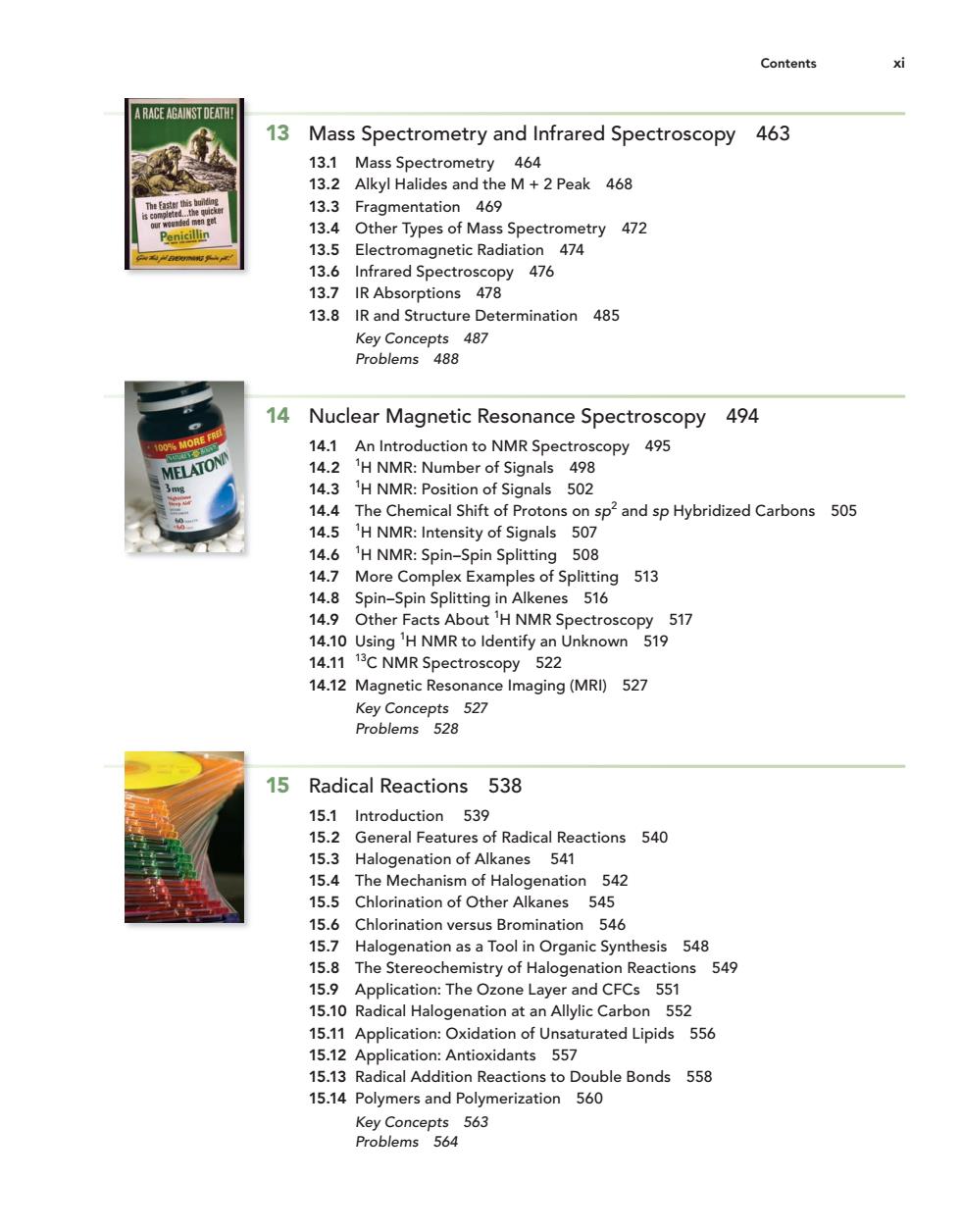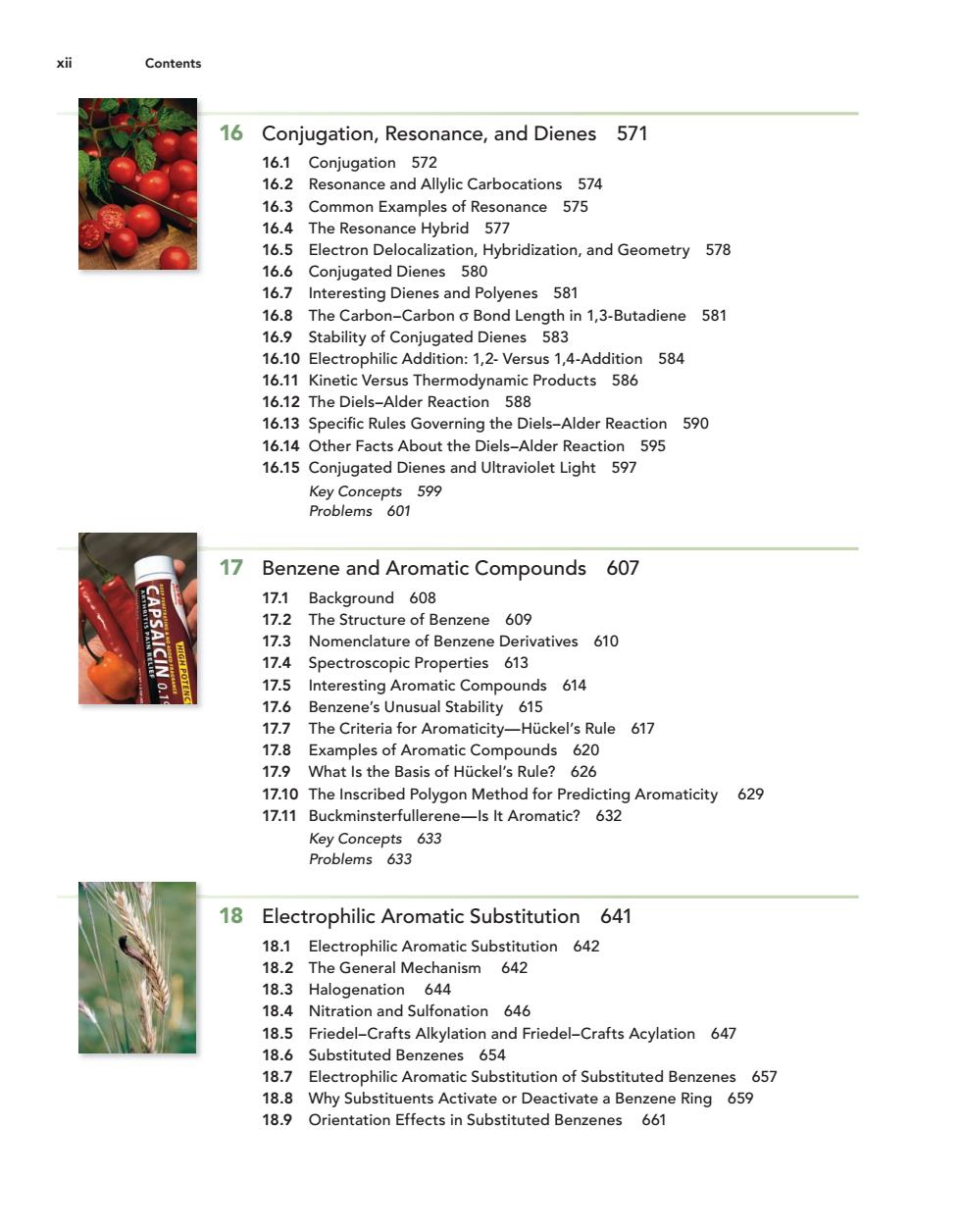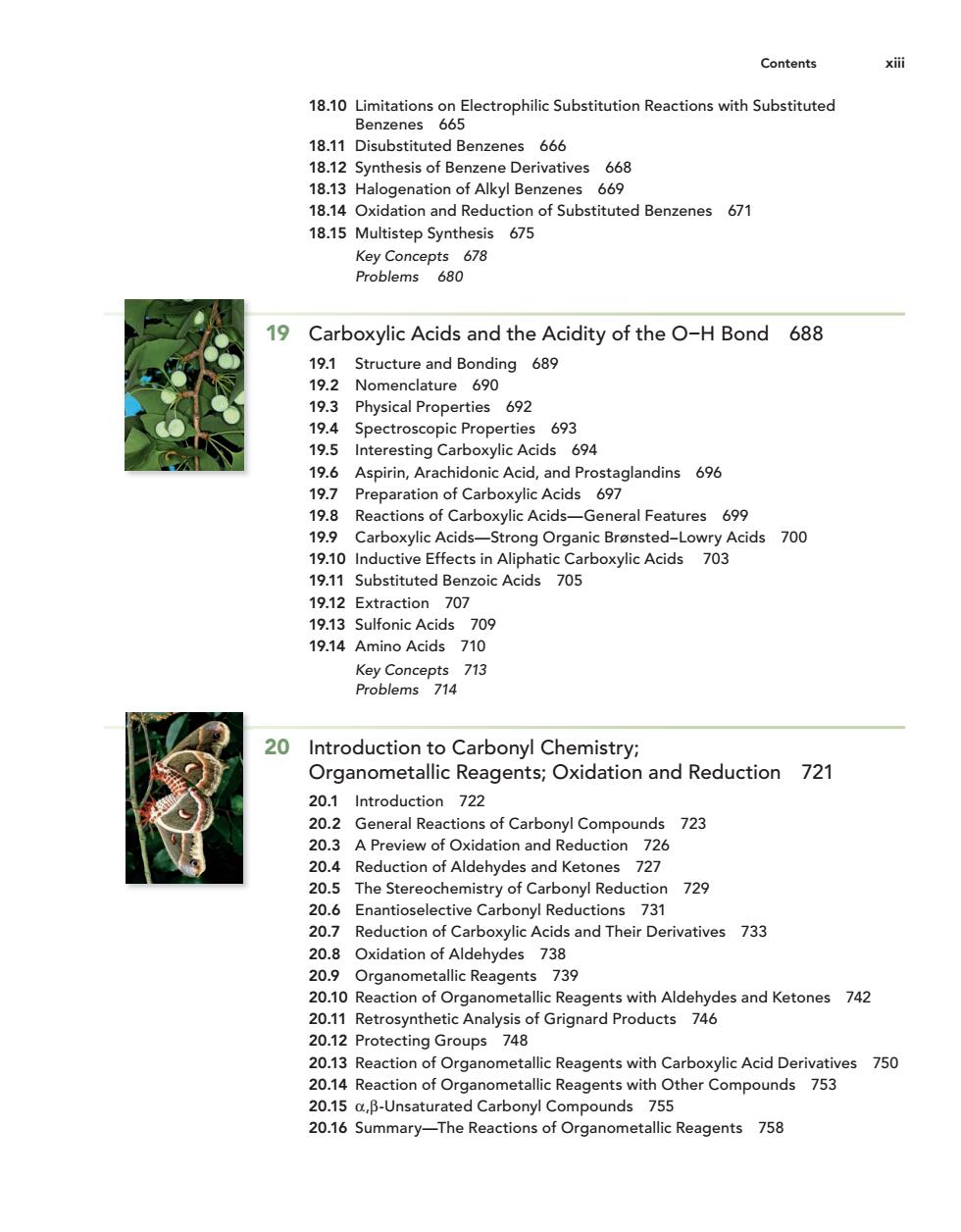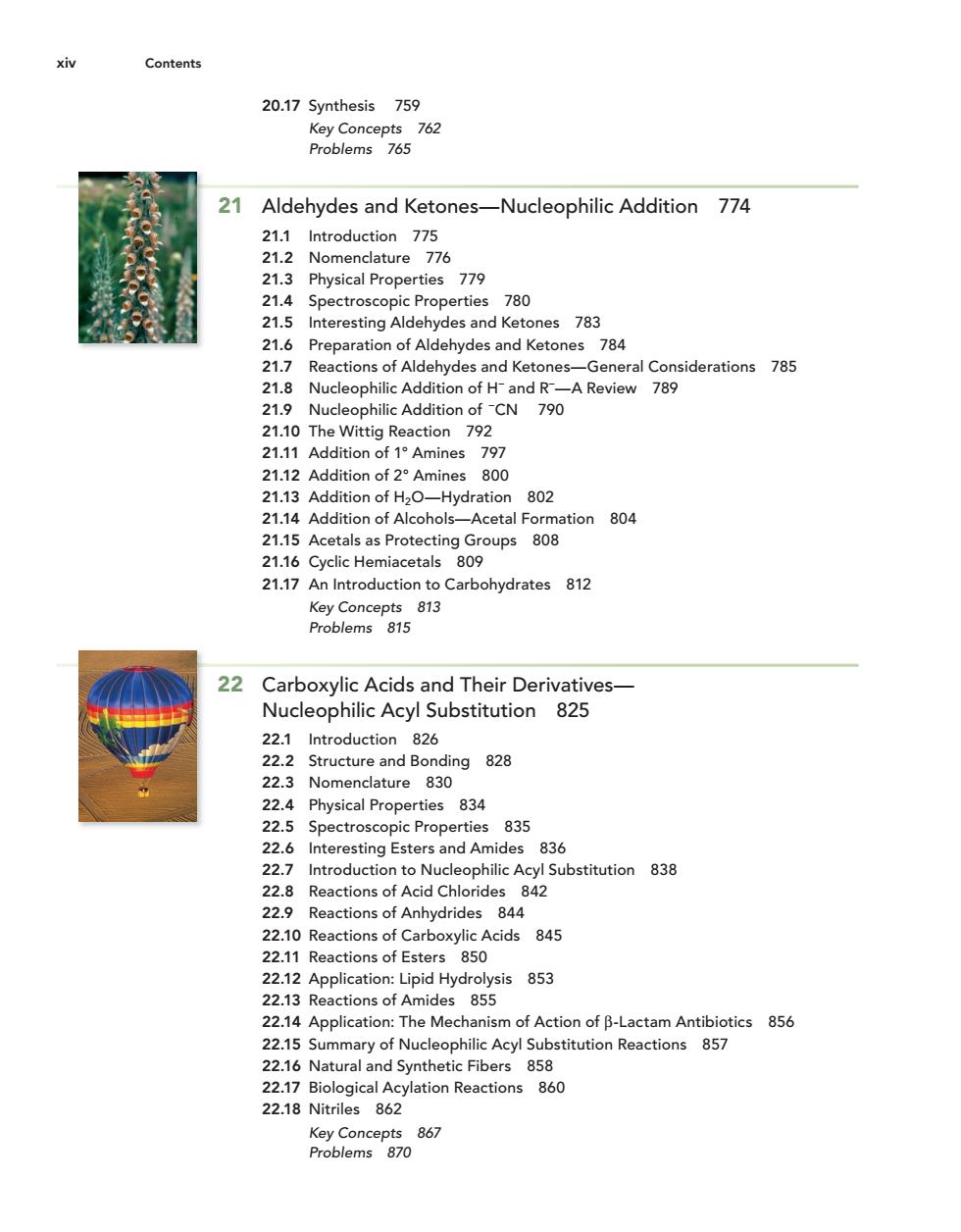
Contents RACE AGAINST DEATH Mass Spectrometry and Infrared Spectroscopy 463 131 Mass Spectrometry 464 13.2 Alkyl Halides and the M+2 Peak 468 13.3 Fragmentation 469 13.4 Other Types of Mass Spectrometry 472 13.5 Electromagnetic Radiation 474 13.6 Infrared Spectroscopy 476 13.7 IR Absorptions 478 13.8 IR and Structure Determination 485 487 Nuclear Magnetic Resonance Spectroscopy 494 14.1 An Introduction to NMR Spectroscopy 495 14.2 H NMR:Number of Signals 498 H NMR:Position of Signals 502 The Chemical Shift of Protons on sp2 and sp Hybridized Carbons 505 14.5 H NMR:Intensity of Signals 507 14.6 H NMR:Spin-Spin Splitting 508 14.7 More Complex Examples of Splitting 513 14.8 Spin-Spin Splitting in Alkene 516 14.9 Other Facts Abo t'H NMR Spectroscopy 517 14.10 Using 'H NMR to ldentify n Unknown 19 14.11 13C NMR Spectroscopy 52 14.12 Magnetic Resonar nce Imaging(MRI) 527 Key Concepts 527 Problems 528 不 Radical Reactions 538 15.1 Introduction 539 15.2 General Features of Radical Reactions 540 15.3 Halogenation of Alkanes 541 15.4 The Mechanism of Halo enation 542 15.5 Chlorination of Other Alka 545 546 Organic Synth 548 mistry of Halogenation React ons 549 Application:The Ozone Layer and CFCs 557 15.10 Radical Halogenation at an Allylic Carbon 552 15.11 Application:Oxidation of Unsaturated Lipids 556 15.12 Application:Antioxidants 557 15.13 Radical Addition Reactions to Double Bonds 558 15.14 Polymers and Polymerization 560 Con
Contents xi 13 Mass Spectrometry and Infrared Spectroscopy 463 13.1 Mass Spectrometry 464 13.2 Alkyl Halides and the M + 2 Peak 468 13.3 Fragmentation 469 13.4 Other Types of Mass Spectrometry 472 13.5 Electromagnetic Radiation 474 13.6 Infrared Spectroscopy 476 13.7 IR Absorptions 478 13.8 IR and Structure Determination 485 Key Concepts 487 Problems 488 14 Nuclear Magnetic Resonance Spectroscopy 494 14.1 An Introduction to NMR Spectroscopy 495 14.2 1 H NMR: Number of Signals 498 14.3 1 H NMR: Position of Signals 502 14.4 The Chemical Shift of Protons on sp2 and sp Hybridized Carbons 505 14.5 1 H NMR: Intensity of Signals 507 14.6 1 H NMR: Spin–Spin Splitting 508 14.7 More Complex Examples of Splitting 513 14.8 Spin–Spin Splitting in Alkenes 516 14.9 Other Facts About 1 H NMR Spectroscopy 517 14.10 Using 1 H NMR to Identify an Unknown 519 14.11 13C NMR Spectroscopy 522 14.12 Magnetic Resonance Imaging (MRI) 527 Key Concepts 527 Problems 528 15 Radical Reactions 538 15.1 Introduction 539 15.2 General Features of Radical Reactions 540 15.3 Halogenation of Alkanes 541 15.4 The Mechanism of Halogenation 542 15.5 Chlorination of Other Alkanes 545 15.6 Chlorination versus Bromination 546 15.7 Halogenation as a Tool in Organic Synthesis 548 15.8 The Stereochemistry of Halogenation Reactions 549 15.9 Application: The Ozone Layer and CFCs 551 15.10 Radical Halogenation at an Allylic Carbon 552 15.11 Application: Oxidation of Unsaturated Lipids 556 15.12 Application: Antioxidants 557 15.13 Radical Addition Reactions to Double Bonds 558 15.14 Polymers and Polymerization 560 Key Concepts 563 Problems 564 smi75625_fm_00i-xxxiv.indd xi 11/17/09 11:21:25 AM

xii Contents 16 Conjugation,Resonance,and Dienes 571 16. 8 74 Common Examples of Resonance 57 16.4 The Resonance Hybrid 577 16.5 Electron Delocalization,Hybridization,and Geometry 578 16.6 Conjugated Dienes 580 16.7 Interesting Dienes and Polyenes 581 16.8 The Carbon-Carbon c Bond Length in 1,3-Butadiene 581 16.9 Stability of Conjugated Dienes 583 16.10 Electrophilic Addition:1,2-Versus 1,4-Addition 584 16.11 Kinetic Versus Thermodynamic Products 586 16.12 The Diels-Alder Reaction 588 16.13 Specific Rules Go es anc Ultraviolet Light 597 17 Benzene and Aromatic Compounds 607 CAPSAICIN 17.1 Background 608 17.2 The Structure of Benzene 609 Nomenclature of Benzene Derivatives 610 Spectroscopic Properties 613 Interest 。 ua Stability 614 615 The Crit teria for Aroma Huckel's Rule 617 620 6 17.10 The Inscribed Polygon Method for Predicting Aromaticity 629 17.11 Buckminsterfullerene-ls It Aromatic?632 Key Concepts 633 Problems 633 18 Electrophilic Aromatic Substitution 641 The Ge eral me 642 Haloger ation 44 and Sul 646 -Crafts Alkylation and Friedel-Crafts Acylation 647 18.6 Substituted Benzenes 654 18.7 Electrophilic Aromatic Substitution of Substituted Benzenes 657 18.8 Why Substituents Activate or Deactivate a Benzene Ring 659 18.9 Orientation Effects in Substituted Benzenes 661
xii Contents 16 Conjugation, Resonance, and Dienes 571 16.1 Conjugation 572 16.2 Resonance and Allylic Carbocations 574 16.3 Common Examples of Resonance 575 16.4 The Resonance Hybrid 577 16.5 Electron Delocalization, Hybridization, and Geometry 578 16.6 Conjugated Dienes 580 16.7 Interesting Dienes and Polyenes 581 16.8 The Carbon–Carbon σ Bond Length in 1,3-Butadiene 581 16.9 Stability of Conjugated Dienes 583 16.10 Electrophilic Addition: 1,2- Versus 1,4-Addition 584 16.11 Kinetic Versus Thermodynamic Products 586 16.12 The Diels–Alder Reaction 588 16.13 Specifi c Rules Governing the Diels–Alder Reaction 590 16.14 Other Facts About the Diels–Alder Reaction 595 16.15 Conjugated Dienes and Ultraviolet Light 597 Key Concepts 599 Problems 601 17 Benzene and Aromatic Compounds 607 17.1 Background 608 17.2 The Structure of Benzene 609 17.3 Nomenclature of Benzene Derivatives 610 17.4 Spectroscopic Properties 613 17.5 Interesting Aromatic Compounds 614 17.6 Benzene’s Unusual Stability 615 17.7 The Criteria for Aromaticity—Hückel’s Rule 617 17.8 Examples of Aromatic Compounds 620 17.9 What Is the Basis of Hückel’s Rule? 626 17.10 The Inscribed Polygon Method for Predicting Aromaticity 629 17.11 Buckminsterfullerene—Is It Aromatic? 632 Key Concepts 633 Problems 633 18 Electrophilic Aromatic Substitution 641 18.1 Electrophilic Aromatic Substitution 642 18.2 The General Mechanism 642 18.3 Halogenation 644 18.4 Nitration and Sulfonation 646 18.5 Friedel–Crafts Alkylation and Friedel–Crafts Acylation 647 18.6 Substituted Benzenes 654 18.7 Electrophilic Aromatic Substitution of Substituted Benzenes 657 18.8 Why Substituents Activate or Deactivate a Benzene Ring 659 18.9 Orientation Effects in Substituted Benzenes 661 smi75625_fm_00i-xxxiv.indd xii 11/17/09 11:21:27 AM

Contents xi 18.10 Limitations on Electrophilic Substitution Reactions with Substituted Benzenes 665 18.11 Disubstituted Benzenes 666 18.12 Synthesis of Benzene Derivatives 668 18.13 Halogenation of Alkyl Benzenes 669 18.14 Oxidation and Reduction of Substituted Benzenes 671 18.15 Multistep Synthesis 675 9 Carboxylic Acids and the Acidity of the O-H Bond 688 19.1 Structure and Bonding 689 19.2 Nomenclature 690 19.3 Physical Properties 692 19.4 Spectroscopic Properties 693 19.5 Interesting Carboxylic Acids 694 Aspirin,Arachidonic Acid,and Prostaglandins69 ration of Carboxylic Acids 697 Reaction ylic Acid eral Features 699 Carboxylic Acids -Str uctive Effe S0bstutedBe cts in Alipl ng Organic Bre rboxylic Acids nzoic Acids 19.12 Extraction 707 19.13 Sulfonic Acids 709 19.14 Amino Acids 710 Key Concepts 713 Problems 714 20 Introduction to Carbonyl Chemistry: Organometallic Reagents;Oxidation and Reduction 721 Introduction 722 General Reactions of Carbonyl Compounds 723 A Preview of Oxidation and Reduction 726 20.4 Reduction of Aldehydes and Ketones 727 20.5 The Stereochemistry of Carbonyl Reduction 729 20.6 Enantioselective Carbonyl Reductions 731 20.7 Reduction of Carboxylic Acids and Their Derivatives 733 20.8 Oxidation of Aldehy 20.9 des 738 etallic Re s739 actio of o me with Alde ydes and Ketones 742 746 Protecting Groups 20.13 Reaction of Organometallic Reagents with Carboxylic Acid Derivatives 750 20.14 Reaction of Organometallic Reagents with Other Compounds 753 20.15 a,B-Unsaturated Carbonyl Compounds 755 20.16 Summary-The Reactions of Organometallic Reagents 758
Contents xiii 18.10 Limitations on Electrophilic Substitution Reactions with Substituted Benzenes 665 18.11 Disubstituted Benzenes 666 18.12 Synthesis of Benzene Derivatives 668 18.13 Halogenation of Alkyl Benzenes 669 18.14 Oxidation and Reduction of Substituted Benzenes 671 18.15 Multistep Synthesis 675 Key Concepts 678 Problems 680 19 Carboxylic Acids and the Acidity of the O–H Bond 688 19.1 Structure and Bonding 689 19.2 Nomenclature 690 19.3 Physical Properties 692 19.4 Spectroscopic Properties 693 19.5 Interesting Carboxylic Acids 694 19.6 Aspirin, Arachidonic Acid, and Prostaglandins 696 19.7 Preparation of Carboxylic Acids 697 19.8 Reactions of Carboxylic Acids—General Features 699 19.9 Carboxylic Acids—Strong Organic Brønsted–Lowry Acids 700 19.10 Inductive Effects in Aliphatic Carboxylic Acids 703 19.11 Substituted Benzoic Acids 705 19.12 Extraction 707 19.13 Sulfonic Acids 709 19.14 Amino Acids 710 Key Concepts 713 Problems 714 20 Introduction to Carbonyl Chemistry; Organometallic Reagents; Oxidation and Reduction 721 20.1 Introduction 722 20.2 General Reactions of Carbonyl Compounds 723 20.3 A Preview of Oxidation and Reduction 726 20.4 Reduction of Aldehydes and Ketones 727 20.5 The Stereochemistry of Carbonyl Reduction 729 20.6 Enantioselective Carbonyl Reductions 731 20.7 Reduction of Carboxylic Acids and Their Derivatives 733 20.8 Oxidation of Aldehydes 738 20.9 Organometallic Reagents 739 20.10 Reaction of Organometallic Reagents with Aldehydes and Ketones 742 20.11 Retrosynthetic Analysis of Grignard Products 746 20.12 Protecting Groups 748 20.13 Reaction of Organometallic Reagents with Carboxylic Acid Derivatives 750 20.14 Reaction of Organometallic Reagents with Other Compounds 753 20.15 α,β-Unsaturated Carbonyl Compounds 755 20.16 Summary—The Reactions of Organometallic Reagents 758 smi75625_fm_00i-xxxiv.indd xiii 11/17/09 11:21:30 AM

xiv Contents 20.17 Synthesis 759 Key Concepts 762 Problems 765 21 Aldehydes and Ketones. -Nucleophilic Addition 774 ature 776 779 780 Interesting Aldehydes and Ketones 783 21.6 Preparation of Aldehydes and Ketones 784 21.7 Reactions of Aldehydes and Ketones-General Considerations 785 21.8 Nucleophilic Addition of H-and R--A Review 789 21.9 Nucleophilic Addition of-CN 790 21.10 The Wittig Reaction 792 21.11 Addition of 1 Amines 797 21.12 Addition of 2 Amines 800 21.13 Addition of HO- 802 21.14 Addition of Alcohols ation 804 oups An Introduction to Carbohydrates 812 Key Concepts 813 Problems 815 22 Carboxylic Acids and Their Derivatives Nucleophilic Acyl Substitution 825 Structure and Bor 22.4 Physical Properties 834 22.5 Spectroscopic Properties 835 22.6 Interesting esters and amides 836 22.7 Introduction to Nucleophilic Acyl Substitution 838 22.8 Reactions of acid chlorides 842 22.9 Reactions of Anhydrides 844 22.10 Reactions of Carboxylic Acids 845 22 11 Reactions of Esters 850 2212A olysis 85 ons R55 22公A。Summsry st Nussphie AsyI SubN23a Applica ion nism of Action of B-Lactam Antibiotics 85 22.16 Natural and Synthetic Fibers 858 22.17 Biological Acylation Reactions 860 22.18 Nitriles 862 Key Concepts 867 Problems 870
xiv Contents 20.17 Synthesis 759 Key Concepts 762 Problems 765 21 Aldehydes and Ketones—Nucleophilic Addition 774 21.1 Introduction 775 21.2 Nomenclature 776 21.3 Physical Properties 779 21.4 Spectroscopic Properties 780 21.5 Interesting Aldehydes and Ketones 783 21.6 Preparation of Aldehydes and Ketones 784 21.7 Reactions of Aldehydes and Ketones—General Considerations 785 21.8 Nucleophilic Addition of H– and R– —A Review 789 21.9 Nucleophilic Addition of – CN 790 21.10 The Wittig Reaction 792 21.11 Addition of 1° Amines 797 21.12 Addition of 2° Amines 800 21.13 Addition of H2O—Hydration 802 21.14 Addition of Alcohols—Acetal Formation 804 21.15 Acetals as Protecting Groups 808 21.16 Cyclic Hemiacetals 809 21.17 An Introduction to Carbohydrates 812 Key Concepts 813 Problems 815 22 Carboxylic Acids and Their Derivatives— Nucleophilic Acyl Substitution 825 22.1 Introduction 826 22.2 Structure and Bonding 828 22.3 Nomenclature 830 22.4 Physical Properties 834 22.5 Spectroscopic Properties 835 22.6 Interesting Esters and Amides 836 22.7 Introduction to Nucleophilic Acyl Substitution 838 22.8 Reactions of Acid Chlorides 842 22.9 Reactions of Anhydrides 844 22.10 Reactions of Carboxylic Acids 845 22.11 Reactions of Esters 850 22.12 Application: Lipid Hydrolysis 853 22.13 Reactions of Amides 855 22.14 Application: The Mechanism of Action of β-Lactam Antibiotics 856 22.15 Summary of Nucleophilic Acyl Substitution Reactions 857 22.16 Natural and Synthetic Fibers 858 22.17 Biological Acylation Reactions 860 22.18 Nitriles 862 Key Concepts 867 Problems 870 smi75625_fm_00i-xxxiv.indd xiv 11/17/09 11:21:32 AM

Contents 23 Substitution Reactions of Carbonyl Compounds at the a Carbon 880 23.1 Introduction 881 23.2 Enols 881 23.3 Enolates 884 23.4 Enolates of Unsy 23.5 891 A Preview of Rea actions at the a rbon 892 on at ne a Carbo 89 te 23.9 Malonic Ester Synthesis 900 23.10 Acetoacetic Ester Synthesis 903 Key Concepts 906 Problems 908 24 Carbonyl Condensation Reactions 916 24.1 The aldol Reaction 917 242 Crossed Aldol Reaction 921 Directed Aldol Reac n 926 r Aldol ctions 926 Re The Crossed Claisen and Re lated Reactions 930 The Dieckmann Reaction 93 24.8 The Michael Reaction 934 24.9 The Robinson Annulation 936 Key Concepts 940 Problems 941 Amines 949 25.1 25.2 950 952 954 25.5 Spectroscopic Properties 955 25.6 Interesting and Useful Amines 956 25.7 Preparation of Amines 960 25.8 Reactions of Amines-General Features 966 25.9 Amines as Bases 966 25.10 Relative Basicity of Amines and Other Compounds 968 25.11 Amines as Nucleophiles 975 25.12 Hofmann Elimination 977 25.13 Reaction of Amines with Nitrous Acid 980 25.14Sub5 ium Salts 982 25.15C0 upling Reactic of Aryl um Salts 986 25.16 Application:Synthetic Dyes 98
Contents xv 23 Substitution Reactions of Carbonyl Compounds at the ` Carbon 880 23.1 Introduction 881 23.2 Enols 881 23.3 Enolates 884 23.4 Enolates of Unsymmetrical Carbonyl Compounds 889 23.5 Racemization at the α Carbon 891 23.6 A Preview of Reactions at the α Carbon 892 23.7 Halogenation at the α Carbon 892 23.8 Direct Enolate Alkylation 897 23.9 Malonic Ester Synthesis 900 23.10 Acetoacetic Ester Synthesis 903 Key Concepts 906 Problems 908 24 Carbonyl Condensation Reactions 916 24.1 The Aldol Reaction 917 24.2 Crossed Aldol Reactions 921 24.3 Directed Aldol Reactions 925 24.4 Intramolecular Aldol Reactions 926 24.5 The Claisen Reaction 928 24.6 The Crossed Claisen and Related Reactions 930 24.7 The Dieckmann Reaction 932 24.8 The Michael Reaction 934 24.9 The Robinson Annulation 936 Key Concepts 940 Problems 941 25 Amines 949 25.1 Introduction 950 25.2 Structure and Bonding 950 25.3 Nomenclature 952 25.4 Physical Properties 954 25.5 Spectroscopic Properties 955 25.6 Interesting and Useful Amines 956 25.7 Preparation of Amines 960 25.8 Reactions of Amines—General Features 966 25.9 Amines as Bases 966 25.10 Relative Basicity of Amines and Other Compounds 968 25.11 Amines as Nucleophiles 975 25.12 Hofmann Elimination 977 25.13 Reaction of Amines with Nitrous Acid 980 25.14 Substitution Reactions of Aryl Diazonium Salts 982 25.15 Coupling Reactions of Aryl Diazonium Salts 986 25.16 Application: Synthetic Dyes 988 smi75625_fm_00i-xxxiv.indd xv 11/17/09 11:21:34 AM